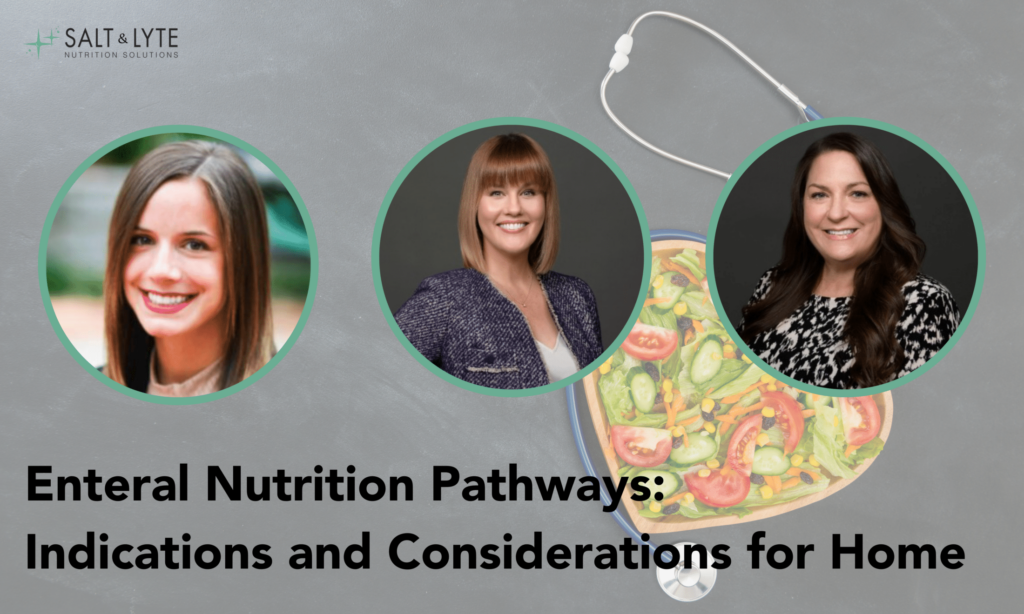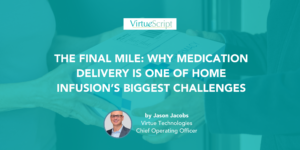Imagine hearing the words “You are going to need a feeding tube” from your provider. You would be understandably shocked, nervous, and probably a little confused. For home infusion patients, this is their reality. Most of them have never even heard of feeding tubes before. They are already grappling with a new diagnosis or treatment, and adding tube feeding to the mix can be really scary. Not to mention that eating food and enjoying meals with loved ones is a cornerstone of culture and a huge source of pleasure for most.
What we have seen while working with home infusion patients is that one size does not fit all. The goal for providers should be to tailor the tube feeding regimen to the patient’s lifestyle, keeping in mind the patient’s individual situation, capabilities, and goals of care. Ideally, tube feeding should fit into the patient’s life rather than becoming the patient’s whole life.
Many patients are also surprised to learn that insurance does not cover ongoing home health nursing services for tube feeding administration at home. Patients will generally receive training at bedside in the hospital or outpatient setting, and then a few home health visits to reinforce teaching. All patients or caregivers are expected to learn to independently administer feedings, flushes, and care for the tube.
This can create additional obstacles and stressful learning curves. A competent DME/home care enteral team, including a nutrition support dietitian, can help ease this stress and instill confidence in the patient or caregiver, thereby increasing the chances of optimal outcomes and compliance.
Currently, there are four different pathways for administration of enteral nutrition available to patients. We will explore each one through the lens of home infusion.
#1 Bolus Feeding
Bolus feeding is the most basic pathway for enteral nutrition requiring the least amount of equipment. It mimics traditional meals or snacks and is very discreet. Bolus feeds deliver a larger volume of formula through a syringe, allowing gravity to pull the formula directly into a patient’s stomach. Bolus feeds should take about 10-20 minutes and are typically administered 4-6 times a day.
Note: Those with feeding tubes placed in the small intestine should NOT administer bolus feeds. The small intestine is not designed to hold large volumes of food or formula at one time. Bolusing formula directly into the small intestine can cause malabsorption, cramping, nausea, and diarrhea.
Patients should flush their tubes with water before and after each feeding. Water flushes are an extremely important part of every tube feeding regimen. The number one cause for hospital admissions in patients with feeding tubes is dehydration, and clogged feeding tubes are a close second. Both issues have a higher chance of prevention with proper water flushes. Patients can use whatever water they would normally drink to flush the tube – distilled or bottled water are not necessary.
Hand dexterity is a key component of bolus feeding. If a patient has difficulty holding or manipulating a syringe, and a caregiver isn’t available to administer the necessary feedings and water flushes, enteral accessories exist to assist with these functions. Issues such as maltolerance to bolus volume will necessitate the need to consider another pathway of feeding. We will go through three more options for these patients to consider.
#2 Gravity Feeding
Gravity feeding administers formula at a slower rate than bolus feeding via a gravity bag hanging from an IV pole. Formula flow is regulated by a manual rolling clamp on the tubing. Gravity feeds are versatile. Intermittent gravity feedings should take about 30-45 minutes per feeding and are typically administered 4-6 times per day. If the patient prefers a longer, more continuous schedule, gravity feedings can be administered over several hours with a slower drip. Gravity bags are often provided by homecare companies to patients as a backup for volumetric enteral pumps in the event of a power outage or pump failure. Per standard enteral feeding protocol, water flushes are still given via syringe before and after each feeding.
To administer, patients pour their tube feeding formula into a gravity bag, hang it on an IV pole, and sit back while the formula infuses. While gravity feeding frees up the patient’s hands during the feeding time, the patient now has to be attached to an IV pole for the duration of the feeding. This may work best for patients who lack the hand dexterity required for bolus feeding, or those who have the freedom to sit for the duration of each feeding and want to use their hands for another task. If a patient feels GI distress with bolus feeding, such as nausea, fullness, or bloating, they can try slowing down the formula delivery with gravity to see if that eliminates their discomfort before moving on to the next enteral pathway- administration via volumetric pump.
#3 Volumetric Pump Feeding
Pump feeding administers enteral formula at a programmed rate over an allocated amount of time. Patients can use a pump for 1) continuous feeding typically over 24 hours, 2) cyclic feeding indicating a schedule over <24 hours, such as over 12 hours overnight, or 3) intermittent feeding to deliver a volume of formula over a controlled amount of time 4-6 times per day. All tube types are appropriate for pump feeding. Pumps come in different shapes and sizes, but portability is key! Dual flush/feed pumps are available that incorporate a water flush along with the formula in the programmed rate.
Patients and/or caregivers learn to set up the feeding set and program the pump to get started. Once set-up is complete, the pump will run for the programmed amount of time or until the bag runs out of formula. Gravity is not required for pump feeding, so patients can place their pumps in backpacks and go about their normal day. Portability allows patients to continue to participate in daily life activities like attending soccer games, church or simply going shopping. Many people choose to infuse their nutrition overnight while they sleep.
Manual water flushes remain an integral part of a pump feeding regimen to provide hydration and prevent clogged tubes. Water flushes should be given before and after each feeding cycle and throughout the day as recommended by their dietitian.
#4 Elastomeric Feeding
For the first time in years, there is a new device on the market, offering a fourth enteral pathway. This feeding system has an internal elastomeric pouch that when filled with formula will consistently deflate. It is portable, lightweight, does not require gravity, and works without electricity/charging, making it the first disposable enteral pump.
Patients with both gastric tubes and small bowel feeding tubes can safely use an elastomeric feeding device. Patients can alter the flow rate by choosing from four different feeding sets. Formula viscosity and the positioning of the device also impact flow rate speed. Feedings can be delivered in as quickly as 20 minutes or as slow as 12 hours.
Note: Patients who require a high degree of flow rate accuracy may prefer a traditional pump.
As with the traditional methods of enteral feeding, patients will need to administer water flushes before and after each elastomeric feeding. The elastomeric is more lightweight than a traditional feeding pump, which could benefit smaller or weaker patients who require a pump-like infusion but wish to be mobile. This feeding system can also offer a slower feeding than both bolus and gravity without the commitment of a traditional pump.
Patients at home on enteral nutrition have four options of feeding pathways. The method of tube feeding delivery will be based on several factors and guided by nutrition support providers. With the right education and direction, every tube feeding patient has the opportunity to find what works best for them and what makes their time on tube feeding comfortable and successful.
Salt & Lyte Nutrition Solutions consults with home enteral nutrition providers including home infusion pharmacies and DME companies across the country. The Salt & Lyte team focuses on three integral pillars of a nutrition support program including clinical excellence, revenue cycle optimization, and program growth & development. The home enteral nutrition space can be complex and challenging. With cost of goods on the rise and reimbursement stagnant, program sustainability can be threatened. Payor criteria alone can be overwhelming! SLNS is committed to partnering with their clients to create streamlined processes, identify clinical solutions and generate realistic pathways leading to program success and ultimately, exemplary patient experience. Patients everywhere deserve the best care possible during what can be the most challenging time of their lives.
Disclaimer: This is NOT clinical advice but merely an Enteral Nutrition overview. Individuals and patients should consult their respective medical providers and clinicians to learn more.
Guest Authors: Mary Rose Tanner, MS, RD, LD is a Registered Dietitian on the Salt & Lyte Consulting Team. Angie Hutton-Walston, RD, CNSC, LD & Marie Groves, MS, RD, CNSC, LD are co-founders of Salt & Lyte Nutrition Solutions, LLC a consulting firm dedicated to enterprise optimization and clinical excellence within the home infusion space, specializing in home enteral (HEN) and home parenteral support (HPN). With over 25 years in the industry, the SLNS Consulting Team of consummate professionals including board-certified nutrition support dietitians and RCM specialists are unmatched.
_____________________________________
WeInfuse is dedicated to keeping infusion simplified by streamlining workflows for home infusion, specialty pharmacies, and infusion centers. WeInfuse software enables infusion operators to operate efficiently, decrease burnout, maximize profits, and improve clinical outcomes.
For more infusion insights, tune into the WeInfuse podcast, download our magazine, and subscribe to our blog.




